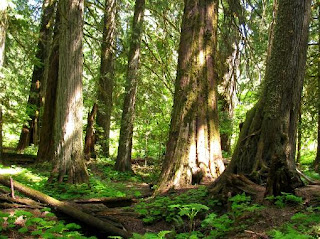Once the new runs come this morning, I will talk about the threat of lightning and strong winds returning to Kittitas County (Cle-Elum to Ellensburg). Talked about it on KPLU this morning (9AM on air or on KPLU.ORG after 9:30 AM)
As our hearts go out to the people who have lost their homes, businesses, and animals in the Taylor Bridge fire near Cle Elum and Thorp, the natural question for west-side residents is: could it happen here? Could a major fire strike the region west of the Cascade crest?
The short answer is yes...it not only can happen but HAS happened, particularly along the western slopes of the Cascades.
The reality of this is brought home by the release today by the National Weather Service of a RED FLAG Warning for some parts of western Washington and Oregon (see graphic). This is exceedingly rare.
Perhaps the most well known west-side fire is the famous Yacolt Burn of Sept. 11-13, 1902, the largest forest fire in Washington state history, which burned 238,920 acres -- more than 370 square miles -- and killed 38 people in Clark, Cowlitz, and Skamania counties.
 |
| Results of the Yacolt Burn |
Then there was the great Tillamook Burn...a series of four fires in the old-growth forecasts along the northern Oregon coast range that destroyed a total of 355,000 acres during the period of 1933-1951.
 |
| Tillamook Burn |
Recently, I read a paper by Hemstrom and Franklin (Quaternary Journal, 1982) in which they talked about the role of big fires at Mount Rainier Park. Looking a tree rings and other evidence, they determined that natural big fires cause trees to be replaced roughly every 430 years in the park. The largest and oldest big fire occurred around 1230 AD and interestingly some of the oldest stands of trees in the the park date to that fire. A place with very old trees is one of my favorite Rainier locations: the Grove of the Patriarchs near Ohanepecosh, which were protected by surrounding water. Some of the trees there are over a 1,000 years old.
 |
| Surrounding rivers helped protect the Grove of the Patriarch from fire. |
For those of you like probcast, it can be found at:
http://probcast.washington.edu/





No comments:
Post a Comment
Please make sure your comments are civil. Name calling and personal attacks are not appropriate.